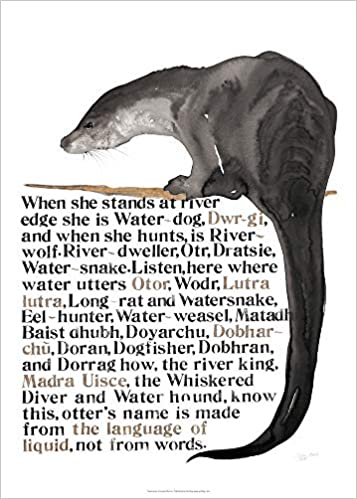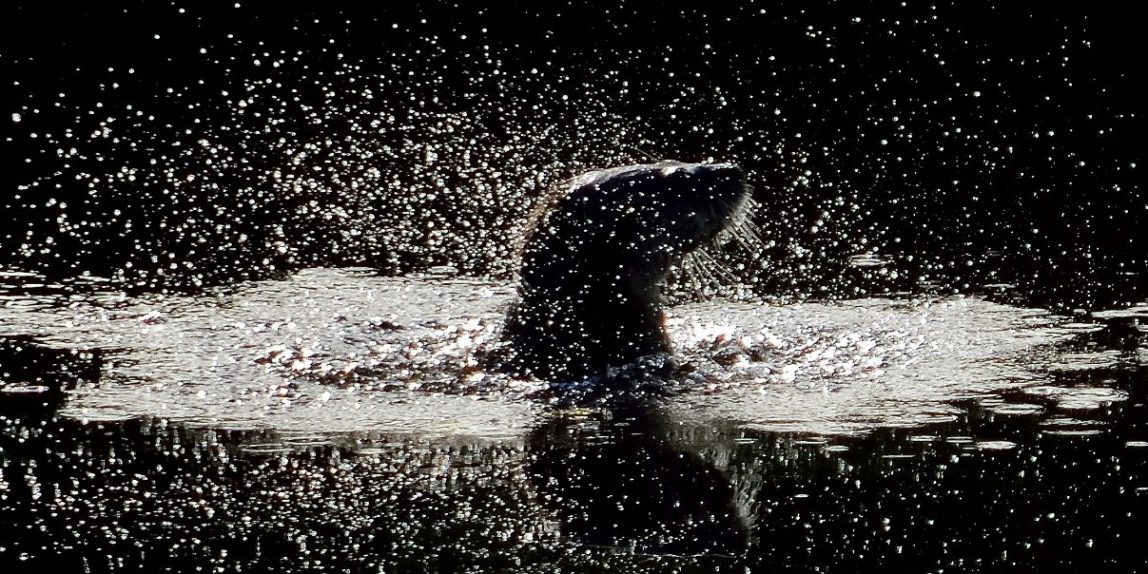A few years ago, whilst on holiday in Hay-on-Wye, the famous book town of Wales, I found myself endlessly drawn to a poster in a shop window. It was Jackie Morris’ evocative illustration, ‘The Names of the Otter’’. I was fascinated by its magical incantation of the animal’s river-names, the words tumbling and rolling like stones in a stream. As a student of the language, I was especially intrigued by the otter’s Welsh name, dwrgi, or water dog.

By kind permission of Jackie Morris
Attracted by the subject matter, Môr a Mynydd (Sea and Mountain), in my local Learner’s Eisteddfod, I chose to write about the journey of the River Dee, or Afon Dyfrdwy, from its source on the dark, eastern slopes of Dduallt in Eryri (Snowdonia), following its course as it gains speed, rolling and spilling into valleys, sometimes meandering and mazy, sometimes rushing and impatient, but moving forwards always through landscape and time, before reaching the wide and shallow basin of the estuary and finally, the open sea.
This river has been special to me since I first attended Golftyn Infants School in Connah’s Quay, an old Victorian building standing on its banks, sadly no longer there, where every spring we would gather in the playground to watch house martins making their nests of river mud in the eaves.
As I sat down to begin writing, the image of the otter was instantly bright in my mind I watched as she slipped from the poster, her sleek and lithe body gleaming as she padded softly along moonlit banks. Listening intently at the water’s edge, she slid suddenly into its silky darkness, her element, and her home. Y dwrgi, the waterdog, had led me to the river.
And so this is how the otter found her way into my poem, my first in Welsh, which I entered into the competition with the encouragement and help of my wonderful and ever-patient tutor, Tesni Wyn. I have included the English translation below the Welsh version of the poem, which I’ve done to the best of my ability, but as they say, there’s always something lost… Aerfen is the water deity, or goddess, of the river, and Llyn Crych y Waun translates quite beautifully as ‘shivering moor lake’.
TAITH AFON DYFRDWY
Sibryda llais Aerfen yn ddistaw bach
Drwy’r creigiau’r Dduallt, ar draws
Llyn Crych y Waun.
O’r uchder tywyll hyn i lawr i’r olau’r dyffryn
Rhed yr afon ddisglair, fel aur o dan yr haul,
Arian dan y lleuad.
A lle nofio’r brithyll brith a helfeydd dwrgi
Dan yr hen bont gerrig
Yma mae’r afon hudolus nawr yn troelli – dan ei bwâu.
Ymlaen ac ymlaen y rhed, drwy’r caeau, pentrefi a threfi,
Fel edau arian sy’n ein cystylltu ni – ein gorffennol i’n dyfodol.
Ac yna, cyrhaedda’r Dyfrdwy’r môr
Lle mae ewyn y don yn gloywi tu hwnt i’r aber mawr
A gwylanod gwyn yn hwylio’r gwynt uwchben y tonnau gwyllt,
I grwydro moroedd y byd i gyd, a galw’r eogiaid adra.
JOURNEY OF THE RIVER DEE
Aerfen’s voice whispers softly through
The rocks of Dduallt, across Llyn Crych y Waun.
From these dark heights the river runs
To the light of the valley below,
Shining like gold beneath the sun,
Mercury beneath the moon,
And where the speckled trout swim and the otter hunts
Beneath the old stone bridges,
The enchanted river swirls and eddies through arches.
On and ever on she runs, through villages, fields and towns,
Connecting us as a silver thread, our past with times to come.
Until at last, the Dee meets the sea,
Where the spray bursts in silver sparks beyond the great estuary,
And seagulls sail the wild, wild wind above the waves and spume,
To search the waters of the world, and call the salmon home.

Absolutely beautiful Sonia!
“Excellent article. I absolutely love this site. Continue the good work!
”
http://obzor-site-ting.ucoz.club/news/dirvt_diskrttivt_bashdvd_hattvb_bivtr/2022-01-20-17